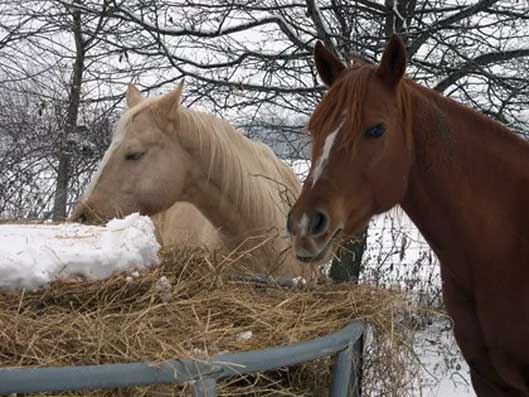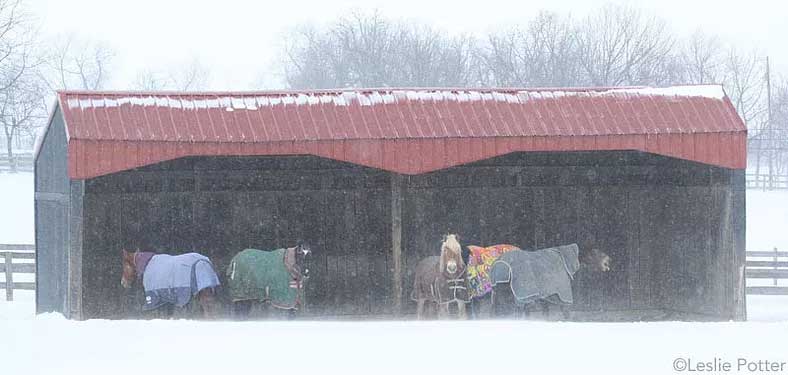
23 Dec 2016 Winter Horse Care
Can my Horse Stay Warm in Winter?
The biggest impact to horses in the winter is the temperature, windchill, and their ability to stay dry. All living creatures have a “critical core temperature” that they have to maintain to stay alive. Depending on how harsh the conditions are, and if your horse is thin, shaved, or blanketed, your horse can either thrive in the winter, or will struggle and lose body weight.
Much of it is also influenced by the current body condition of the horse before the weather starts to change.
Your horse’s body will automatically speed up or slow down chemical reactions which produce heat within their body, depending on the surrounding temperature and their body condition.
Horses with a heavy coat and in moderate body condition will have a lower critical temperature (around 30 F) than horses with a wet or short coat in moderate body condition (around 50 F). In general for each decrease in temperature of 1 degree Fahrenheit below the critical temperature, there is an increase in digestible energy requirements of 1% for body temperature maintenance. Under cold and wet conditions, when access to shelter is unavailable or limited, this can greatly increase a horse’s energy needs.
For example, a temperature drop of 10 degrees F under the critical temperature with windchill and/or rain may lead to an additional need for 10-15 Mcal per day or add up to 25 lbs of dry matter (hay and or grain) per day. Many horses would not be able to consume this volume of feed in hay alone.
Adjustments in feed
To meet a horse’s increased caloric needs it may be necessary to change to a more nutritious source of feed (hay and/or grain), especially since hay is already inferior in calories compared to fresh grass, which the horse may have been eating before the winter.
A diet mainly consisting of forage is ideal, but to meet the elevated energy needs, other sources of energy may need to be added, such as starches or fat. However, it is very important to keep in mind that fiber, present in forage, is utilized through bacterial fermentation in the hind gut of the horse and it will produce much more heat than the digestion of low fiber feedstuffs which are digested in the foregut.
It is also important to note that changes should be managed gradually as sudden changes in type or quantity of feed can cause upset in the intestinal system of the horse and can lead to colic, laminitis or even cause the horse to founder.
Hydration and water requirements
As temperatures fall, horses tend to reduce their water intake as well. This, combined with an increased forage consumption in the form of dried hay can lead to a greater risk of impaction colic. Water requirements actually increase since hay and grain typically contain less than 15% moisture, while fresh pasture possesses 60 to 80% moisture.
Water needs to be available at all times and should stay between 45 and 65 degrees. Ice should be immediately removed and snow is not to be considered a source of water. Often horses will be more inclined to drink when the water offered is at a more palatable temperature than the ambient temperature.
Adding plain salt to the horse’s diet (up to 4 tablespoons a day) will also greatly increase appetite for water and help with hydration. Salt blocks are not recommended as the horses will not be inclined to lick a frozen block and there is no accurate way to monitor the intake.
Shelter needs
Although horses don’t necessarily need to be stabled, protection from the elements is desirable. Escaping from bitter winds and moisture will greatly help horses kept outside to acclimatize to the changes in the weather conditions. This in turn will also help them maintain their body temperature without having to increase the caloric intake as much.
Blanketing
Naturally, the hair coat acts as an insulation layer by trapping air. Winter coats will continue to grow in until the days start to lengthen again after the winter solstice on December 21st.
However, when the hair is wet or full of mud, air is excluded and the insulating value is reduced, making way for heat loss. Even a little rain can cause matting of the hair and thus cold stress. It is very important to keep your horse dry and sheltered from moisture. Blanketing is often done based on the comforts of the owner, but at times it is necessary to blanket the horse, especially if there is no shelter available during turnout periods. Also if there is a chance the horse will become wet, has been clipped, has not been acclimated or the horse is very young or old and in poor body condition it is advisable to blanket the horse.
Coat and Hoof care
Hoof care must still be kept on schedule during the winter. It may be beneficial to the horse to have his shoes pulled if minimal or no riding will be done. It gives the horse’s feet a chance to go back to its natural ability to contract and expand and it prevents the feet from being ice packed, leading to possible injuries.
Hooves still need trimming every 6-8 weeks to prevent cracks and unwanted breakage, but keeping in mind that some extra sole will help cushioning on the frozen ground.
Exercise
Exercise can be a challenge during winter months. Horses may be confined for longer periods during extreme weather with the risk of lower leg edema (stocking up). Keeping the horse moving is essential, but it can be a challenge to cool down a horse with a thick winter coat when being exercised. Leaving a hot, wet horse standing in the cold can lead to illness so care has to be taken.
The main areas of concern are:
- Access to shelter
- Access to additional fiber (preferably from forage) and fat
- Access to warm water
- Regular hoof care and assessment of body condition
- Opportunity to move around or to be exercised.

